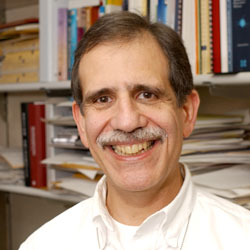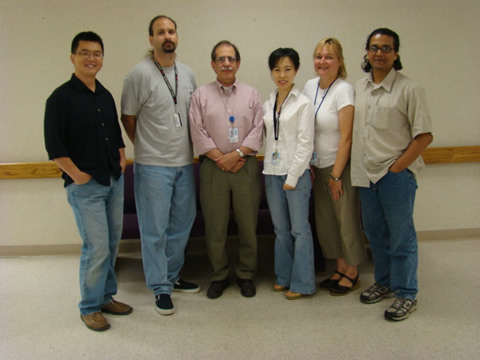| |
| |
| Barry Horwitz, Ph.D., Senior Investigator |
 |
Dr. Horwitz received his B.A. degree from Washington University in St. Louis and his Ph.D. in physics from the University of Pennsylvania. After several years of teaching physics, he joined the NIA as a Senior Staff Fellow in the Laboratory of Neurosciences, headed by Stanley I. Rapoport. Dr. Horwitz's work focused on developing methods for using positron emission tomography to determine how different brain regions interact in human subjects. In 1989, he obtained tenure and in 1999 he joined the Language Section, NIDCD, as a Senior Investigator. In 2002, he became Chief of the Brain Imaging and Modeling Section of NIDCD. Dr. Horwitz's laboratory currently studies the neural basis of human cognition, especially auditory and language function, using functional brain imaging and computational neural modeling.
|

|
Staff:

- Dr. Yvonne Bennett, Research Fellow, (301) 594-7758 bennetty@mail.nih.gov
- Dr. Fatima Husain, Ph.D., Special Volunteer, (217) 333-7561 husainf@uiuc.edu
- Dr. Jieun Kim, Visiting Fellow, (301) 594-7757 kimjieun@mail.nih.gov
- Ajay Pillai, Ph.D., Visiting Fellow, (301) 594-5141 pillaiaj@mail.nih.gov
- Dr. Feng Rong, Visiting Fellow, (301) 451-1657 rongf@mail.nih.gov
- Dr. Jason F. Smith, Postdoctoral Fellow, (301) 451-1647 smithjas@mail.nih.gov
Research Interests:
Current research focuses on understanding how the brain constructs networks of interacting regions (i.e., neural
networks) to perform cognitive tasks, especially those associated with audition and language, and how these
networks are altered in brain disorders. These issues are addressed by combining computational neuroscience
techniques with functional neuroimaging data, obtained using fMRI, PET, or MEG. The network analysis methods
allow us to evaluate how brain operations differ between tasks and between normal and patient populations. This
research will allow us to ascertain which networks are dysfunctional, and the role neural plasticity plays in enabling
compensatory behavior to occur. A unique aspect of our research is that most of the experiments we do are linked to
our modeling, in that these experiments are performed to either acquire data for developing our models or else for
testing them.
|
Selected Recent Publications:
Horwitz, B., Wise, R.J.S. (2008) PET research of language, Handbook of the Neuroscience of Language , 71-80.
Horwitz, B., Husain, F.T. (2007) Simulation frameworks for large-scale brain systems, Handbook of Brain Connectivity , 275-302.
Lee, L., Friston, K.J., Horwitz, B. (2006) Large-scale neural models and Dynamic Causal Modelling, NeuroImage 30, 1243-1254.
Husain, F.T., Lozito, T., Ulloa, A., Horwitz, B. (2005) Investigating the neural basis of the auditory continuity illusion,, J. Cogn. Neurosci. 17, 1275-1292.
Horwitz, B., Warner, B., Fitzer, J., Tagamets, M.-A., Husain, F.T., Long, T.W. (2005) Investigating the neural basis for functional and effective connectivity: Application to fMRI, Phil. Trans. Roy. Soc. Lond. B 306, 1093-1108.
Husain FT, Tagamets MA, Fromm SJ, Braun AR, Horwitz B. (2004) Relating neuronal dynamics for auditory object processing to neuroimaging activity: a computational modeling and an fMRI study., Neuroimage 21(4), 1701�20.
Glabus MF, Horwitz B, Holt JL, Kohn PD, Gerton BK, Callicott JH, Meyer-Lindenberg A, Berman KF. (2003) Interindividual differences in functional interactions among prefrontal, parietal and parahippocampal regions during working memory., Cerebral Cortex 13(12), 1352�61.
All Selected Publications
Contact Information:
Dr. Barry Horwitz
Brain Imaging and Modeling Section
Voice, Speech and Language Branch, NIDCD
Building 10, Room 8S235
10 Center Drive MSC 1407
Bethesda, MD 20892-1407
Telephone: (301) 594-7755 (office),
(301) 480-5625 (fax)
Email: horwitzb@mail.nih.gov
|
|















